Executive Summary
For those of us who drive to work or take long car trips, our cars already serve as our offices, breakfast nooks, concert halls, vanity tables and even movie theaters for the kids. As smartphones (which used to be called mobile phones) are now our mobile portals to the Internet, it’s logical that Internet connectivity would be added to our cars, since we spend so much time in them. Moreover, since size is not at such a premium in automobiles as it is in smartphones, cars can achieve more solid connections to the Internet, making for a better browsing experience. Given that family members often sit in the car ignoring each other and gazing at their own individual smartphones, automobiles are increasingly offering Wi-Fi as an option, so that the family can continue to surf the Web while traveling to their next destination.
Automobiles will become just another node in the Internet of Things (IoT), which Cisco forecasted would include 50 billion connected devices by 2020. Interestingly, most of the value in connecting our cars centers on improving the function of the machine—on improving performance and service, and detecting maintenance issues—rather than on entertainment. For entertainment, we’ve been able to connect our phones to our car stereos via Bluetooth for quite some time.
Tesla is the clear technology leader in the industry, since its car was designed to be electric and electronic from the ground up. Its ability to use over-the-air software updates to improve performance and even correct small issues is a stroke of pure genius that could eliminate our need to take our cars to the shop for maintenance, repairs or even fleetwide recalls. This is a huge potential disruptor for the global automobile repair and maintenance industry, and other manufacturers are moving in this direction.
Apart from Tesla, there are other familiar technology leaders and emerging leaders in the connected-car space. Apple and Google have adapted their respective smartphone technologies to form the central nervous system of car-operating systems, and chip companies such as Qualcomm and NVIDIA are working on machine-vision systems for self-driving cars.
This is not a self-driving automobile report, yet we consider it important to mention them. Google appears to be the current leader in the sector, with its fleet of self-driving cars driving around the neighborhood surrounding its Mountain View, California, headquarters and collecting reams of data. Although there are many smart people working on self-driving cars, these vehicles are several years away from arriving on the market, since there are still huge problems to be solved (such as figuring out a way for the cars to deal with unanticipated events—a tree falling into the road or a child chasing a ball into the road, for example).
For the rest of us, many practical advances are available today, such as help with parking, assisted driving, and even help finding a parking place or making dinner reservations. The market for self-driving cars is large and compelling; it’s even spurred China’s big three Internet companies—Alibaba, Baidu and Tencent—to develop their own technologies.
Connected cars are just another thing connected to the IoT, yet they can hugely benefit our daily lives in terms of convenience and safety, and by eliminating the need to put our cars in the shop so often. Moreover, they enable the whole family to surf the Internet at higher speeds while traveling.
Connected Cars: A Key Part of the Internet of Things (IoT)
Normally when we envision the IoT, we think of Internet-connected consumer electronic devices, household appliances or wearable devices. By thinking in this manner, however, we’re overlooking one very important device that has a ubiquitous presence in our lives: the car, which functions for many as a mobile office, dining room or even dressing room. The electronics and technology in automobiles have moved far beyond the basic car stereo to include electronic ignition systems, advanced infotainment systems and hardware that all provide safety and convenience. Today, cars are routinely outfitted with DVD players and connectivity for music players and smartphones. Since we consumers have become accustomed to being connected all the time, it was a logical next step that the place where most of us spend so much of our time—our cars—be connected to the Internet as well. The current state of technology has turned our cars into wireless hubs that offer better signal quality than our ever-smaller smartphones, enabling the whole family to enjoy high-quality connectivity while on trips.
However, the greatest benefits connected cars bring will be under the hood. Most of the value in connecting cars will be in improving their operation in terms of service updates and advance notification of failures, so that being stranded by the side of the road will be a thing of the past. State-of-the-art cars, such as Teslas, are outfitted with networks of cameras and image processors that keep us from drifting into other lanes, running off the road, and colliding with cars and other objects, and that provide conveniences such as assisted driving and automated parking.
At this point, it’s important to distinguish connected cars from electric and hybrid cars, though electric cars such as Teslas are highly connected and offer a vision of the future for the entire global automotive industry. There’s still much progress to be made in terms of automobiles becoming more usable and safe, and ordinary internal-combustion vehicles can become connected via aftermarket upgrades to receive many of the same features. In many high-volume consumer vehicles, connectivity currently exists only between the entertainment system and a smartphone, which remains the primary means of connecting to the Internet. Still, driverless cars are grabbing a great many headlines and are unanimously perceived as the future of the car industry.
Connected cars were deliberately included in Cisco’s well-known “50 billion by 2020” prediction, meaning that 50 billion devices will be connected to the Internet by the year 2020. In a 2011 white paper, Cisco pointed out that “[t]oday’s cars, for example, have multiple networks to control engine function, safety features, communications systems, and so on.” As the IoT evolves, these networks, and many others, will be connected with added security, analytics and management capabilities. This will allow the IoT to become even more powerful in terms of what it can help people achieve. The diagram below shows that there are already more connected devices than there are people in the world, and that our cars are likely one of the 3.47 devices per person included in this year’s total.
As with most technological advances, with convenience and benefits also come weaknesses and opportunities that unethical people can exploit. While previously the worst that could happen to an automobile was theft or vandalism, now owners of connected cars must be prepared for an information-age scourge: hacking. In a recent demonstration, hackers were able to take control wirelessly of a Jeep traveling at a speed of 70 mph and cause it to crash. This is notable due to the wireless mode of entry, whereas previous successful hacking attempts had only been made through the onboard diagnostic port (which is used to add connected features to ordinary automobiles.)

Source: Cisco
Interestingly, as a Cisco blog post titled “10 Predictions for the Future of the Internet of Things” points out, the primary function of connecting a car to the Internet is to improve driving-related functions:
The “Connected Car” will be all about the car – There is currently a lot of hype about turning your car into a mobile entertainment center – music, video, social media and all of the apps that we currently enjoy on our smartphones. However, the real value and transformation is in connecting the car operations (e.g., service updates, advanced notifications of failures) and drastically improving safety (e.g., inter-car communications, semi-autonomous driving). These services will most likely be paid for by the manufacturer or through new, alternative business models, rather than directly by the driver.
In a 2014 report, the consulting firm Strategy& (formerly Booz & Company) elaborated on what this new landscape will look like for players in the industry. The firm anticipates that six distinct product categories will emerge in the connected-car space, based on the functionalities enabled by new connective technologies.
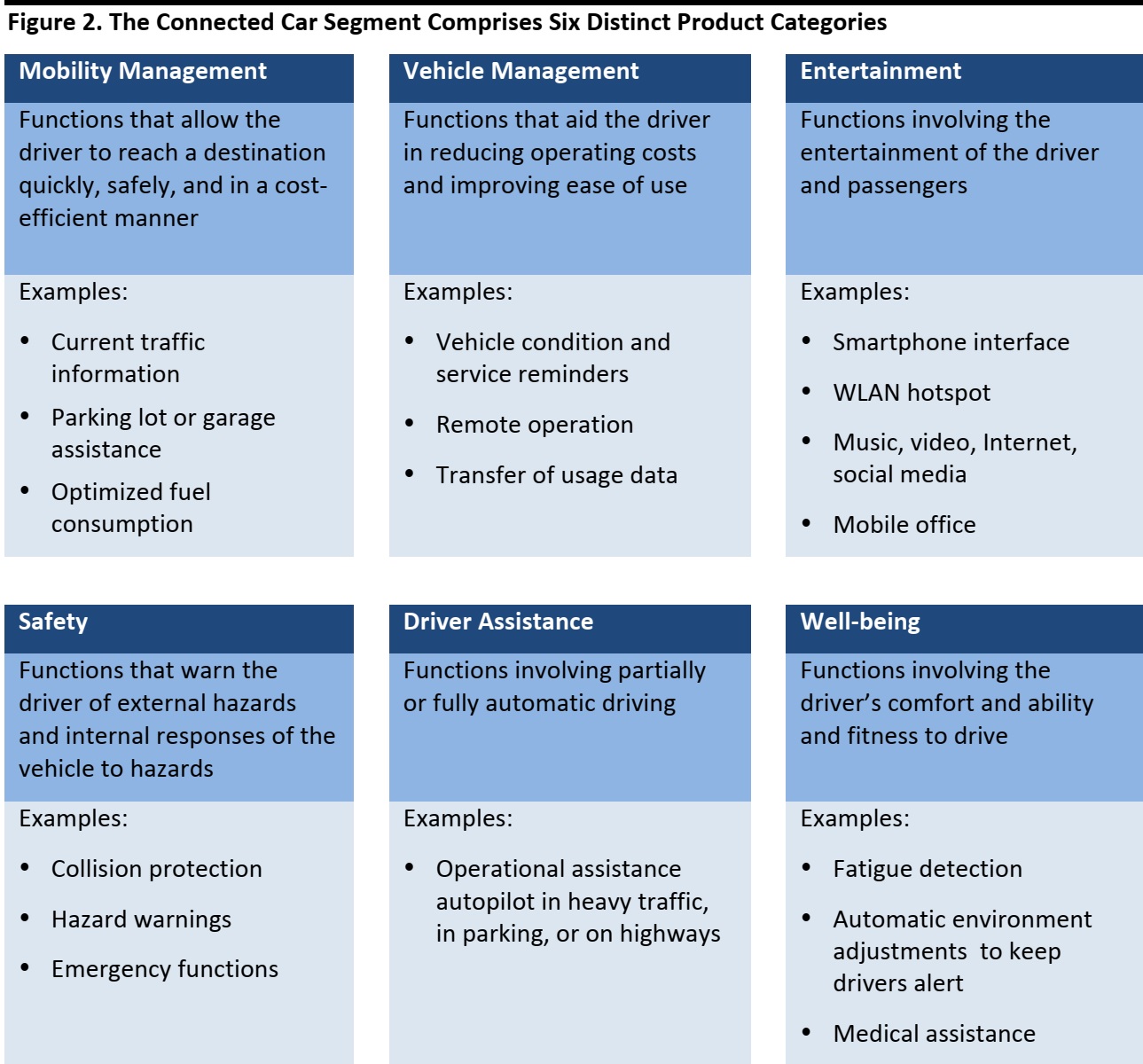
Source: Strategy&
While the entertainment product category is well developed in most new car models, the race for leadership in the other categories among automakers is still very much alive. Increasingly, however, the new connected vehicle environment looks like it will be a challenging place for traditional car companies. Dominance in the new product categories is very much dependent on technological aptitude, which means that these categories have the potential to turn into niche markets for innovative technology companies that can provide better solutions based on software design.
In terms of how the connect car world will develop over time; KPMG anticipates that it will take fifteen years for us to see truly connected vehicles. In a recent report, the consulting firm predicts that the connected car technology will evolve in five stages:
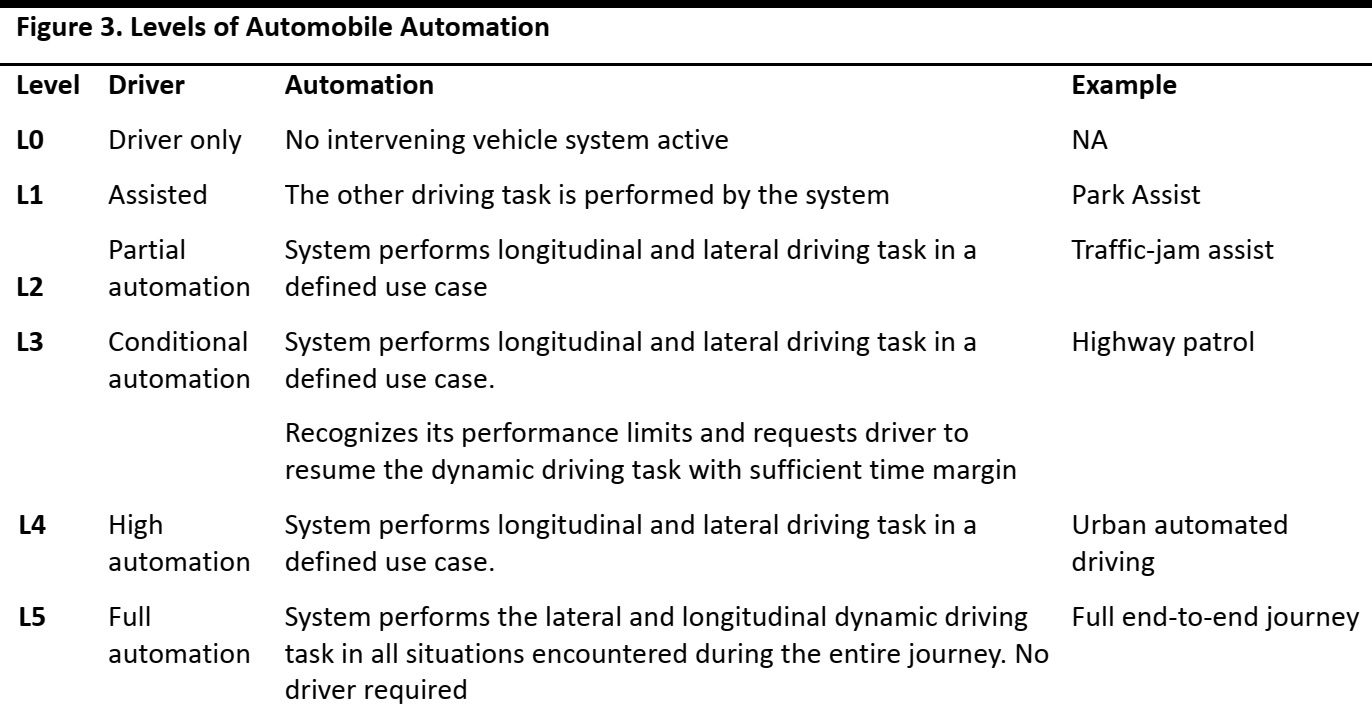
Source: KPMG
The timeline below shows the development of the various automation levels for connected cars.

In the graph below, we see that KPMG forecasts connected-car penetration to steadily increase from 2015 on, reaching full saturation in 2026. The firm sees level 3 production penetration rates increasing and then plateauing in 2024, and level 4 production penetration also increasing (please see definitions above), albeit at a lower level.
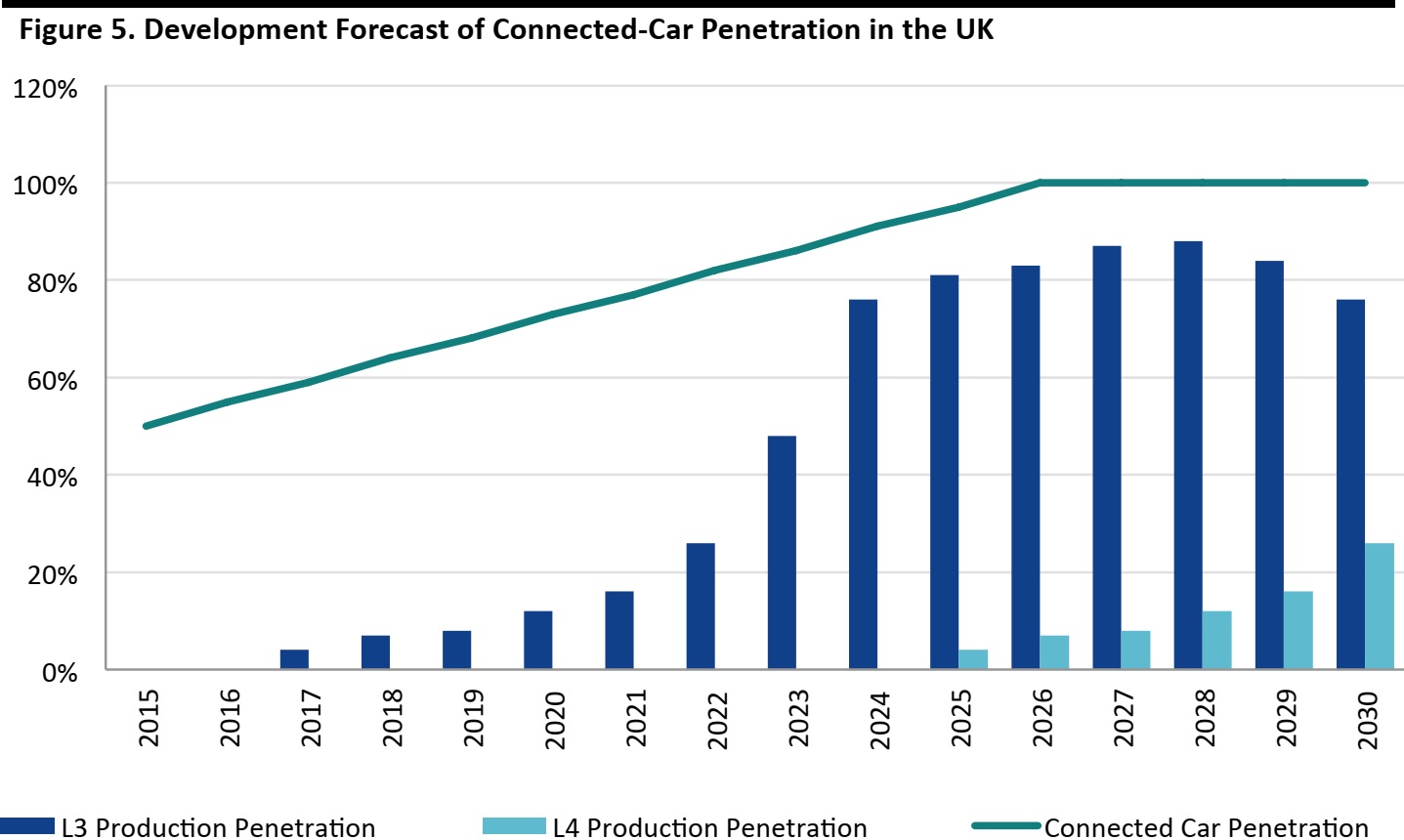
Source: KPMG
The predictions for the development of connected-car technologies point to a rapid transformation of the automobile market. The new market for connected vehicles will blend traditional car production with technological capabilities on the supply side, and will revolutionize consumer behavior on the demand side. As with any other fundamental market shift, the move from traditional vehicles to connected ones presents both a challenge and an opportunity for car companies. More importantly, each manufacturer will need to make two key strategic decisions:
- Whether to pursue a connected vehicle program that leverages embedded connective technology, smartphone-based technology or a hybrid of both
- To what extent it will rely on partnerships for the increasingly complex technology and service models that connected vehicles necessitate
We’ll touch on these strategic decisions later in this report, when we describe the different approaches car companies have undertaken with regard to the connected vehicle opportunity. First, however, let’s take a look at where the market stands today.
The Global Automobile Market
KPMG forecasts that the global market for light-duty vehicles will be 90 million units this year, and grow at a 4.3% CAGR, to 111 million units, in 2020.
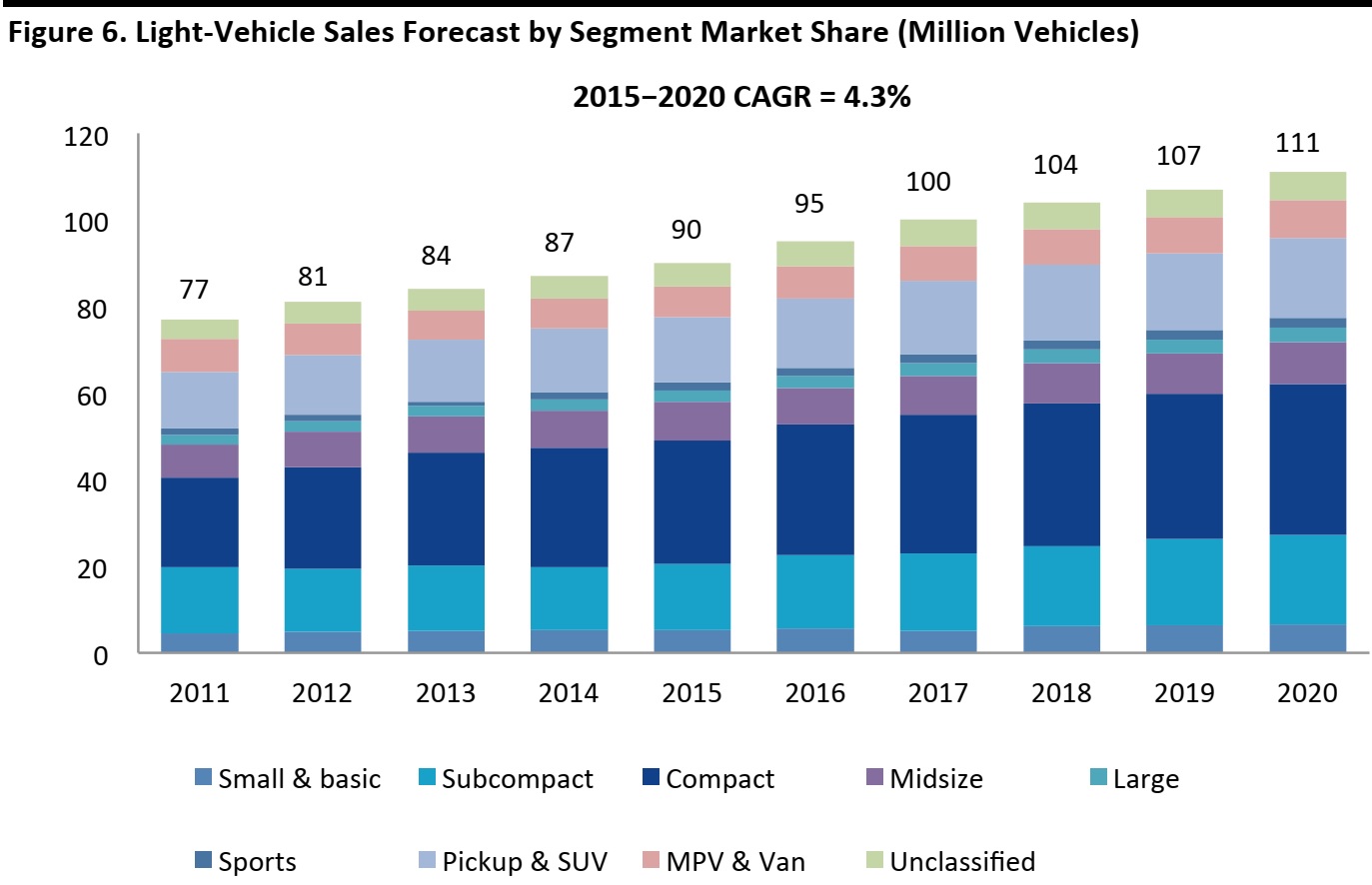
Source: KPMG Competence Center Automotive and LMC Automotive
McKinsey & Company forecasts that the market share of cars connected to the Internet will more than double over the same time horizon (2015–2020), reaching 22% of all vehicles by 2020.

Source: McKinsey & Company
In terms of segmentation within the connected vehicle market, Strategy& estimates that the dominant segment is the driver assistance category, followed by safety applications, then entertainment.
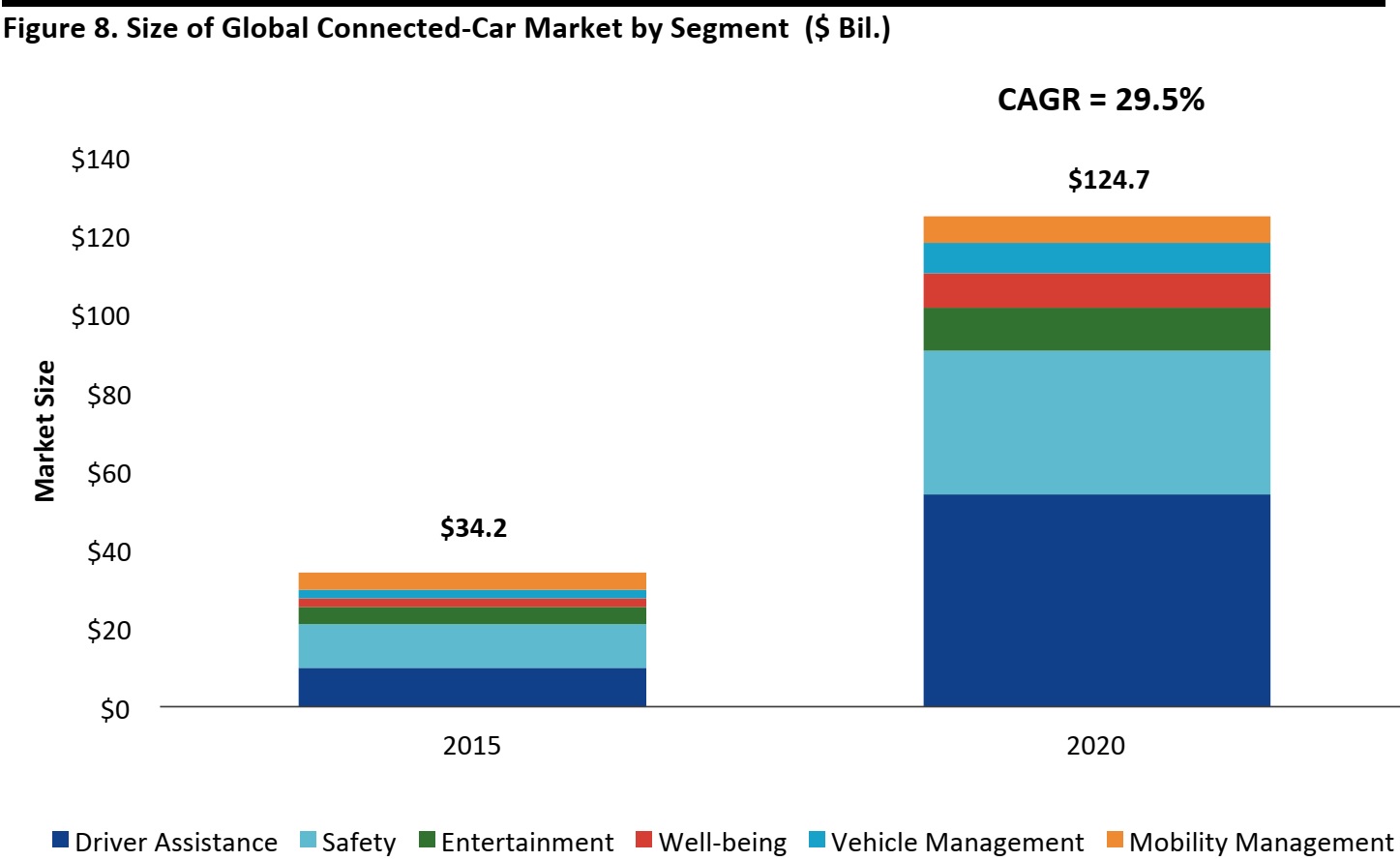
Source: Booz and Company
Longer term, estimates show the market continuing its rapid growth, reaching more than 400 million registered IoT vehicles in 2030.

Source: ABI Research
Connected-Car Technology in the Aftermarket
[caption id="attachment_87422" align="alignright" width="352"]
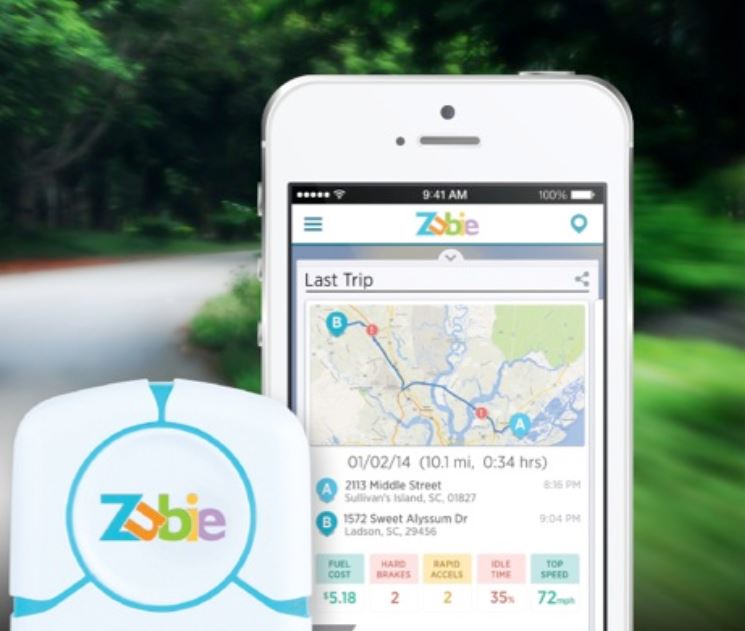 Source: Zubie.com
Source: Zubie.com[/caption]
Given the increasing number of new car models with better connectivity, there’s a large market for adding aftermarket connectivity to vehicles already on the road. The solution is probably in the hands of startup companies such as Zubie and Mojio, as well as Delphi Automotive and even AT&T, all of which are targeting the connected-car aftermarket.
Zubie and Mojio have developed connected devices that plug into the OBD-II (on-board diagnostic system) ports of cars. Through their respective mobile apps, these devices enable users to access driving and operations data, such as vehicle performance, location and driving habits.
Research firm Parks Associates estimates that there is a large addressable market for aftermarket solutions, since there are currently 233 million cars without a connectivity solution in the US alone.
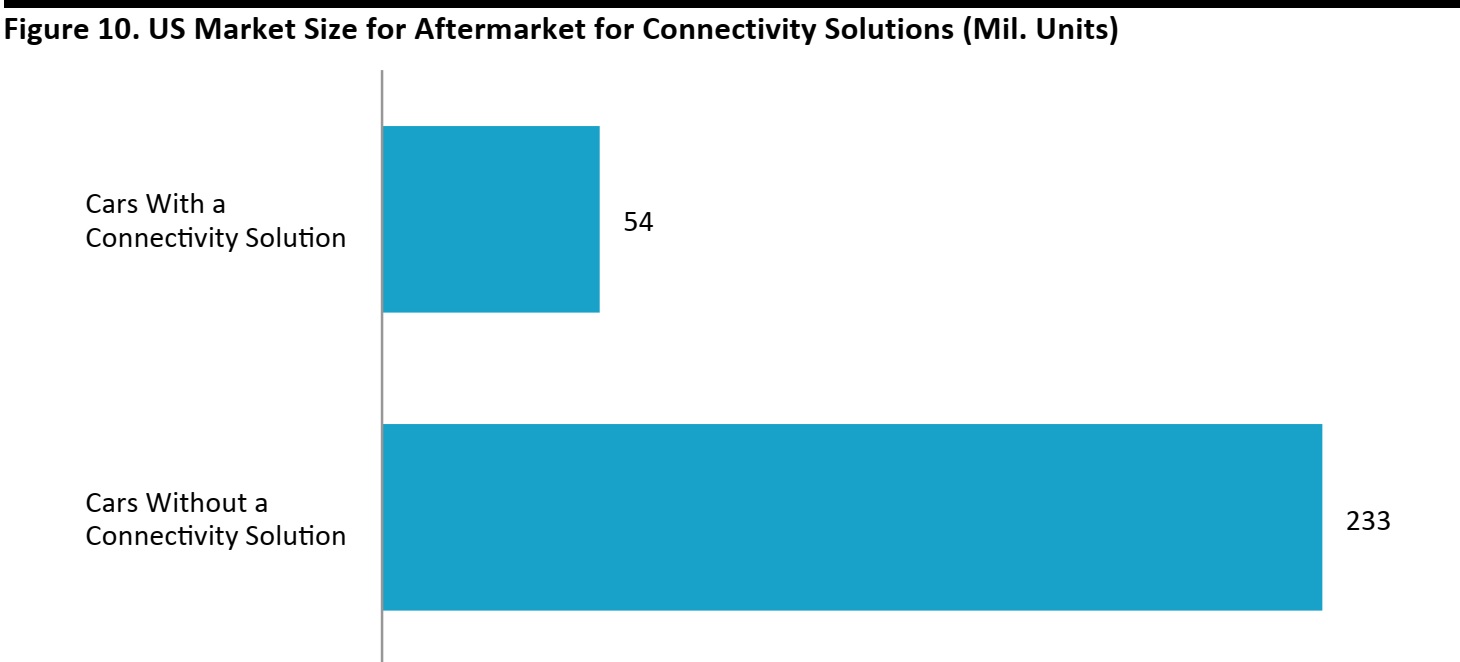
Source: Parks Associates
Potential Disruption of the Automobile Repair and Maintenance Market
The global automobile repair and maintenance market could be severely disrupted by connected cars’ ability to repair themselves. Market research firm Global Industry Analysts forecasted that the global auto repair service market will exceed $305.8 billion by 2015, and the graph below breaks down the $230 billion US aftermarket in 2012.
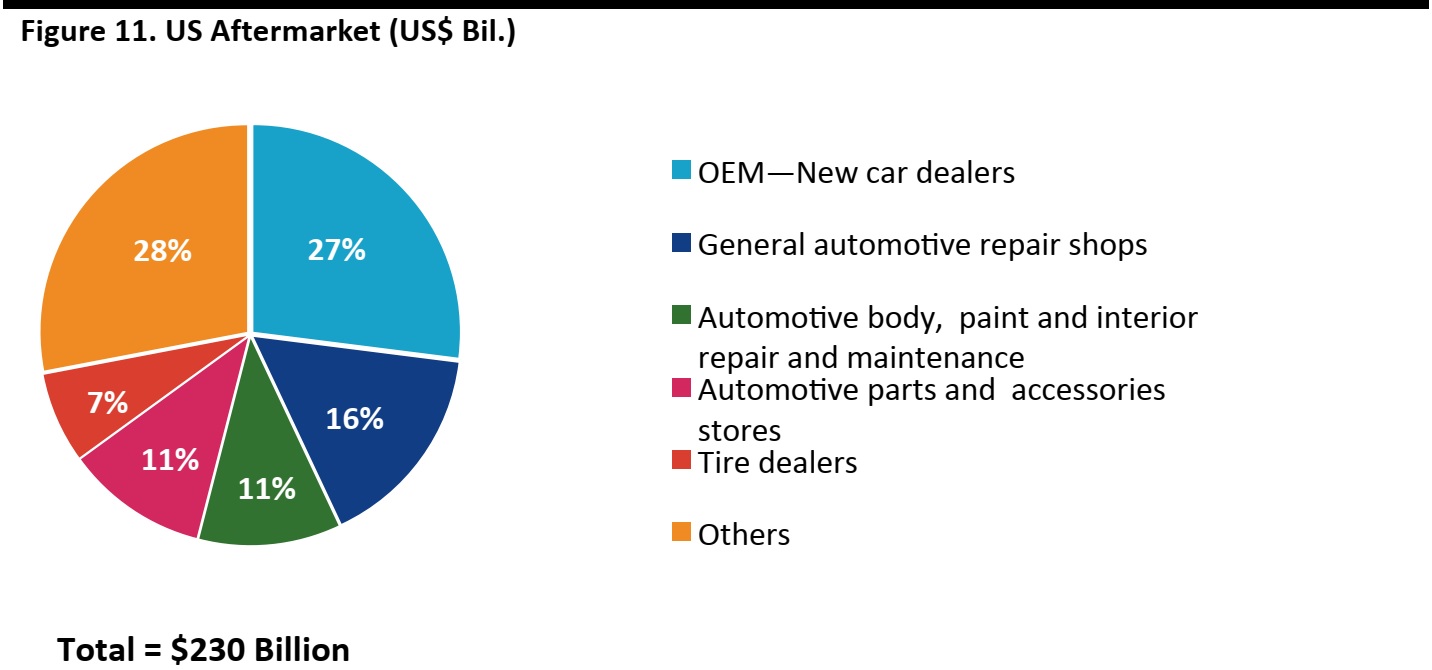
Source: AIAA; Roland Berger
With Tesla and other companies able to effect small changes via over-the-air software updates, manufacturers will need to issue fewer recalls, and owners will have to put their cars in the shop much less frequently. That means lower service revenue for dealer shops and third-party service centers.
What the Carmakers Are Doing
In this section, we discuss four groups of companies: the Big Three US carmakers (plus one other significant one), European carmakers, Asian carmakers and technology companies such as Apple that are active in connected cars. The table below highlights leading automakers and key financial, innovation and technology metrics. In the table, we see that most major automobile vendors rely on Bluetooth links to drivers’ smartphones for connectivity.
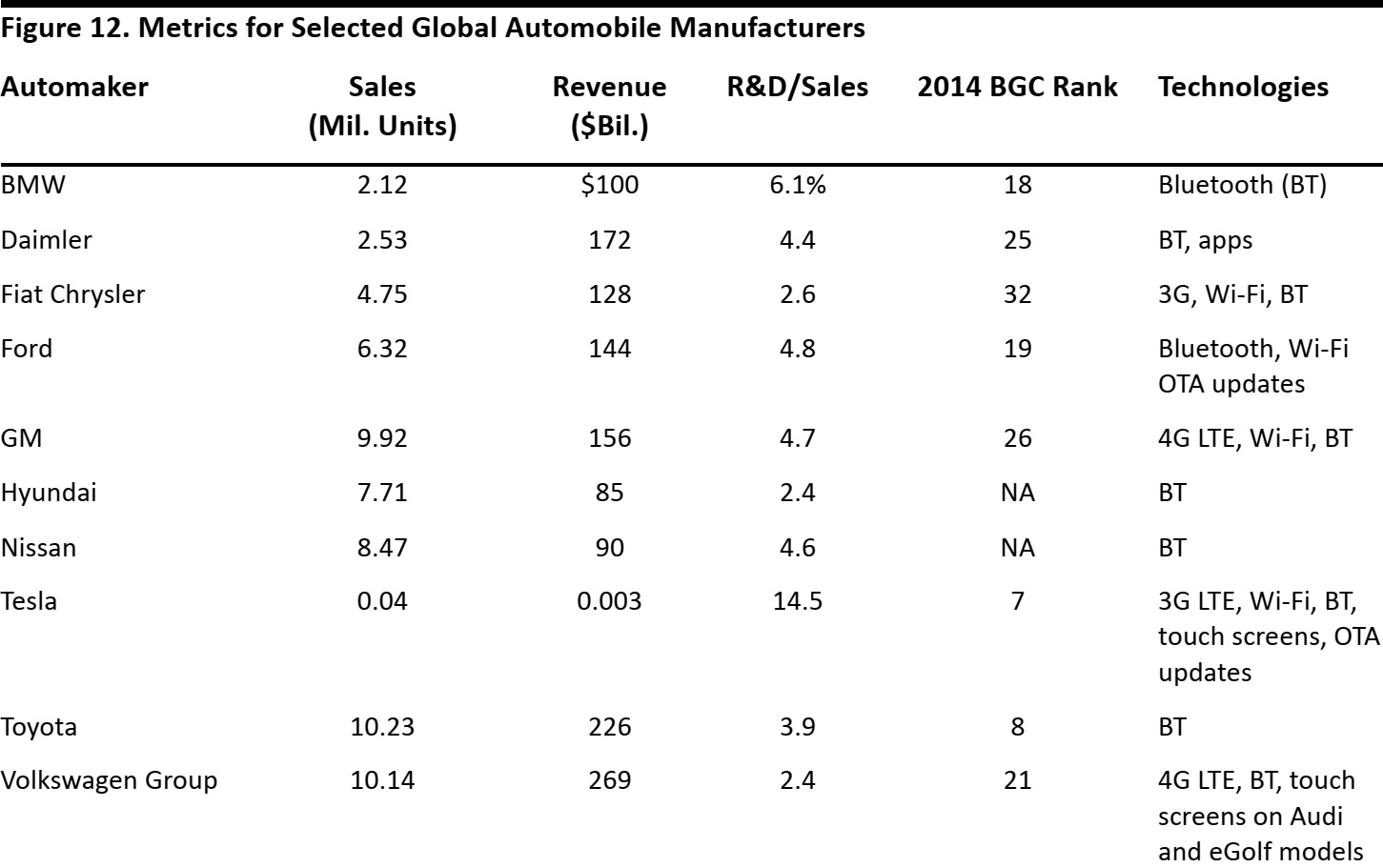
Source: Companies/Statista/BCG Most Innovative Companies/FBIC
Surprisingly, automobile company executives are generally more concerned with profitability and enhancing the operation of internal-combustion engines than with making major improvements in the connectivity of their vehicles, as seen in KPMG’s annual survey.

Source: KPMG
Big-Three US Carmakers, Plus One Significant One: Tesla
Tesla represents the gold standard for electric and connected cars thanks to its over-the-air software updates that can add features or even correct minor design flaws. Tesla Motors was founded in 2003 by technology visionary Elon Musk, who previously founded PayPal in addition to several other companies. Musk is also the founder of commercial aeronautics company SpaceX. Tesla manufactures electric vehicles that compete within the F-segment, which corresponds to full-size luxury cars. The company, headquartered in Palo Alto, California, completed an initial public offering in 2010, raising $226 million, and has a current market value of $33.5 billion.
Tesla is also leveraging the rechargeable-battery technology developed for automobiles in a new venture to manufacture a battery designed to store surplus solar energy generated in homes, which it calls Powerwall. The batteries will be manufactured in a new factory (the Gigafactory) under construction in Reno, Nevada. Deliveries are expected to start this summer. Tesla’s original car model was called the
Roadster, and a total of 2,500 have been sold. The car features quick acceleration; it can go from zero to 60 mph in 3.7 seconds and can drive 244 miles on a single charge. Base priced at $109,000, it was selected as the 2013 Car of the Year by
MotorTrend Magazine.
The
Model S is Tesla’s current flagship model, and a total of 57,000 of them were delivered through the end of 2014. The company expects to manufacture another 55,000 vehicles this year. The model received the highest safety rating of any car ever tested by the National Highway Traffic Safety Administration in 2013. The next major release of Tesla’s automobile software—version 7.0—is expected to offer autopilot mode, which follows the road, can change lanes when the driver taps the turn signal, and provides a warning when the car merges into an occupied lane or approaches a stopped car too quickly. The Model S features all-wheel drive in single- or dual-motor configurations, accelerates from zero to 60 mph in just 3.1 seconds, and can travel up to 270 miles on a charge. Tesla advertises the Model S as an automobile, rather than as a connected device; however, the car is outfitted with GPS, Bluetooth, Wi-Fi and Internet connectivity, and a 17-inch touch screen.
Tesla has already booked 20,000 orders for its
Model X sports utility vehicle, which will come with falcon-wing doors and all-wheel drive powered by two independent motors. Delivery is estimated for September 2015, and the vehicle is expected to have a price tag of $70,000 to $105,000, a range of 215–270 miles and an acceleration of 0 to 60 in 3.5 seconds.
The
Model 3, currently under development, is being called an “all-electric vehicle for the masses.” It’s priced at $35,000 and expected to be demonstrated in 2016 before going into production in 2017.

Tesla has already booked 20,000 orders for the Model X sports-utility vehicle, which will come with falcon-wing doors and all-wheel drive powered by two independent motors. Delivery is estimated in September 2015, and the vehicle is expected to have a price tag of $70,000 to $105,000, a range of 215–270 miles, and an acceleration of 0 to 60 in 3.5 seconds.
The Model 3, currently under development, is being called an “all-electric vehicle for the masses,” priced at $35,000 and expected to be demonstrated in 2016 and going into production in 2017.
Tesla also boasts about its
Supercharger—termed the world’s fastest charging station—which can charge a Model S in “minutes instead of hours.” The company currently operates 453 Supercharger stations with 2,519 Superchargers. These are located near restaurants, shopping centers and Wi-Fi hotspots. Owners can locate charging stations via Google Maps on the car’s 17" touch screen.
Over-the-Air (OTA) Software Updates
Tesla has issued several software updates to correct and improve the performance of its cars, eliminating the need for owners to take their cars into a shop for service. In one case, Tesla owners received a recall notice from the National Highway Traffic Safety Administration recommending that a charger plug be replaced due to potential fire hazard. Tesla corrected the problem via a software upgrade. In 2014, in response to issues that had emerged in accidents, the company updated its cars’ suspension settings to provide greater clearance at high speeds. The shipping version of Tesla’s software for the Model S is version 6.2, which takes 45 minutes to download via a home Wi-Fi network and includes automatic notification of nearby charging locations, trip-planning assistance, automatic emergency braking, blind spot warning and valet mode, among other features.
Ford

Ford calls its connectivity technology SYNC, which was announced at the 2007 Detroit International Auto Show and released that same year. SYNC uses a combination of voice commands, radio and steering-wheel buttons, and touch screens to allow drivers to control in-vehicle, entertainment, and smartphone or media player communications via Bluetooth.
Today, SYNC is offered in most Ford and Lincoln models and comes in three varieties:
- SYNC uses hands-free technology that lets drivers make calls, listen to music, use voice control, select applications using AppLink (which allows the driver to launch and control smartphone apps via the car’s voice command interface), and perform other functions.
- SYNC with MyFord Touch lets drivers operate its electronic systems with a combination of voice commands, buttons on the steering wheel and a customizable touch screen.
- SYNC 3, announced at the 2015 CES in January, is Ford’s new communications and entertainment system. It promises to be faster, more intuitive and easier to use thanks to conversational speech recognition technology, a smartphone-like touch screen and easy-to-read graphics. It will be available in the 2016 Escape and Fiesta cars and in F-150 trucks. SYNC 3 can be updated via a Wi-Fi connection.
Apps that support SYNC AppLink include Allergy Alert, iHeartRadio, MLB.com At Bat, MOG, NPR News, OpenBeak, Pandora, Roximity, Scout by TeleNav, Slacker, Stitcher, SYNC Destinations and TuneIn.
In his 2015 CES remarks, Ford CEO Mark Fields commented that Ford was not interested in achieving a “marketing claim” of being the first to market with a self-driving car. Still, the company has created a research team based in Silicon Valley that’s charged with working on connectivity, mobility and autonomous vehicles, and Fields stated that “[t]here will be a fully autonomous vehicle on the road sometime in the future.” At present, Ford is focusing on bringing semi-autonomous features, such parallel parking assistance, to its more affordable models.
General Motors

Since 1996, GM cars have offered the OnStar system, which connects a driver to a 24/7 lifeline. The current version provides real-time, on-demand diagnostics via a RemoteLink mobile app. Starting in 2015, most new Chevrolet, Buick, GMC and Cadillac vehicles have offered OnStar with 4G LTE connectivity, which includes the following features:
- A built-in Wi-Fi hotspot
- Support of up to seven mobile devices simultaneously
- A comprehensive in-vehicle safety and connectivity system
- Stronger signal strength to the vehicle than to a smartphone, for a more reliable connection
At the third annual Connected Car Conference held in New York City in June this year, Buick announced that both Apple CarPlay and Android Auto will be available for all 2016 Buick Regal and LaCrosse models.
Fiat Chrysler
Fiat Chrysler’s Uconnect + Wi-Fi by Mopar service offers a standard package of entertainment, roadside assistance, alarm notification, stolen vehicle tracking and vehicle diagnostics on a weekly or monthly subscription basis. A subscription to a service providing Wi-Fi and 3G cellular connectivity is also available for an extra fee. About half of the 2015 Dodge, Jeep and Ram pickup trucks support Uconnect.
European Manufacturers
Underscoring the importance of telematics, at press time Volkswagen, Daimler, and BMW had agreed in principle to pay €2.5 billion (US$ 2.7 billion) for Nokia Here, Nokia’s digital-mapping service. If the deal is completed, the German automakers plan to invite other automakers including Fiat Chrysler, Renault, Peugeot Citroën, Ford and Toyota to invest in the unit. The business is based on Navteq, which Nokia acquired for $8.1 billion in 2008. Nokia Here generated more than half of its €970 million in 2014 sales from the automotive industry, with the remainder coming from location-based services.
Volkswagen Group (Audi/VW/Porsche)
The Volkswagen Group is comprised of 12 brands, including Volkswagen Passenger Cars, Audi, SEAT, ŠKODA, Bentley, Bugatti, Lamborghini, Porsche, Ducati, Volkswagen Commercial Vehicles, Scania and MAN, from seven European countries. Below are some brand highlights:
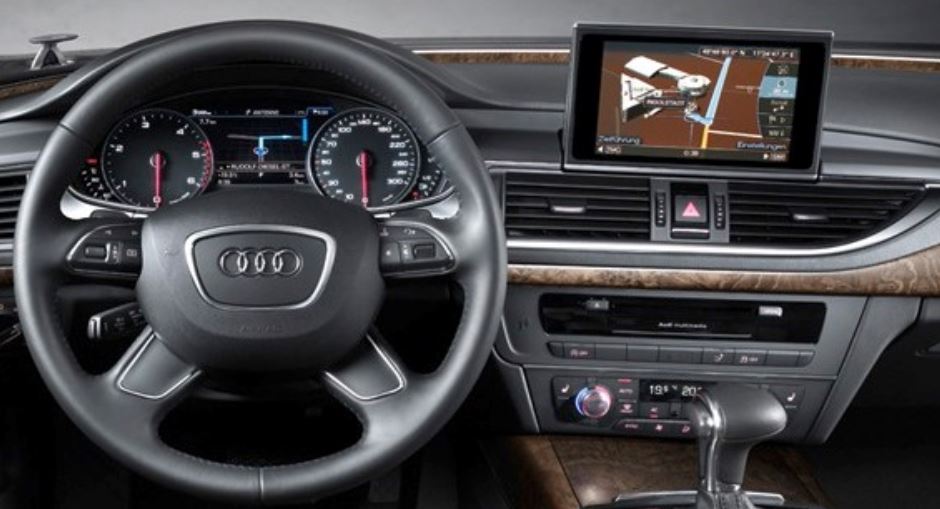 Audi
Audi started offering a 4G LTE wireless option in its A3 models in spring 2014. At the 2015 CES show, the carmaker demonstrated its new Q7 model and started calling its cars “mobile device[s],” demonstrating innovations such as voice-controlled navigation systems. If a driver says, for example, “Take me to the nearest Italian restaurant,” the navigation system will immediately display the best route.
Audi Connect is the company’s software that links a smartphone to Apple CarPlay and Android Auto, and the Q7 and TT models have an optional virtual cockpit that displays 3-D graphics and animations. The system also provides a Wi-Fi hotspot for up to eight devices and 4G wireless connectivity. The Q7 includes technology such as a Predictive Efficiency Assistant and adaptive cruise control, including a congestion assistant, which is a step toward piloted-driving technology. To demonstrate this technology, the company drove a concept car that used piloted driving from Silicon Valley to Las Vegas.
Audi’s most-recent A4 model, targeted to compete with BMW’s 3-series, is loaded with technology, including an 8.3” screen, the abovementioned virtual cockpit, Apple CarPlay and Android Auto, 4G LTE mobile hotspot connectivity, LED headlights, wireless cellphone charging, a heads-up display, and intelligent adaptive cruise control.
Audi’s most recent model, the A4, is targeted to compete with BMW’s 3 Series. The A4 is loaded with technology, including an 8.3" screen, the above-mentioned virtual cockpit, Apple CarPlay and Android Auto, 4G LTE mobile hotspot connectivity, LED headlights, wireless cellphone charging, a heads-up display, and intelligent adaptive cruise control.
Volkswagen demonstrated the
e-Golf, or Connected Golf, at the 2015 CES show. The car includes VW’s latest-generation MIB II infotainment system, the latest version of its App-Connect software (which includes MirrorLink car connectivity software, and Android Auto and Apple CarPlay), tablet and smartwatch integration, intelligent charging, and guided parallel parking and exiting. The Golf R Touch is a highly electronic car that uses
three flat-panel touch displays: a 12.8" high-resolution infotainment touch screen; an 8" Control Center for vehicle, climate control and media functions; and a 12.3" Active Information Display. The unique part is that these displays have incorporated gesture control, so that the driver is not distracted when selecting functions on the displays.
Porsche-branded vehicles use Porsche Car Connect software. The software includes Remote Services, which allow the driver to access vehicle information remotely and also control selected functions; Vehicle Tracking Services, which help the owner protect the car against theft and locate it if it’s stolen; and E-Mobility Services, which offer information and options tailored for vehicles with hybrid drive. The software also integrates with the new Apple Watch.
BMW
ConnectedDrive is a suite of products offered to BMW owners. It includes:
- Services such as Internet search via Google and the exchange of information with the vehicle through My Info / Send to Car, which allows the driver to send information and addresses to the vehicle, find travel information, send and reply to e-mail, listen to music or audio books, and connect to social networks.
- Applications, including online applications, Glympse (which enables the driver to inform people about his or her location in real time), Google services, and Life360 (which connects families), as well as the usual apps for music, entertainment and social networking.
Daimler
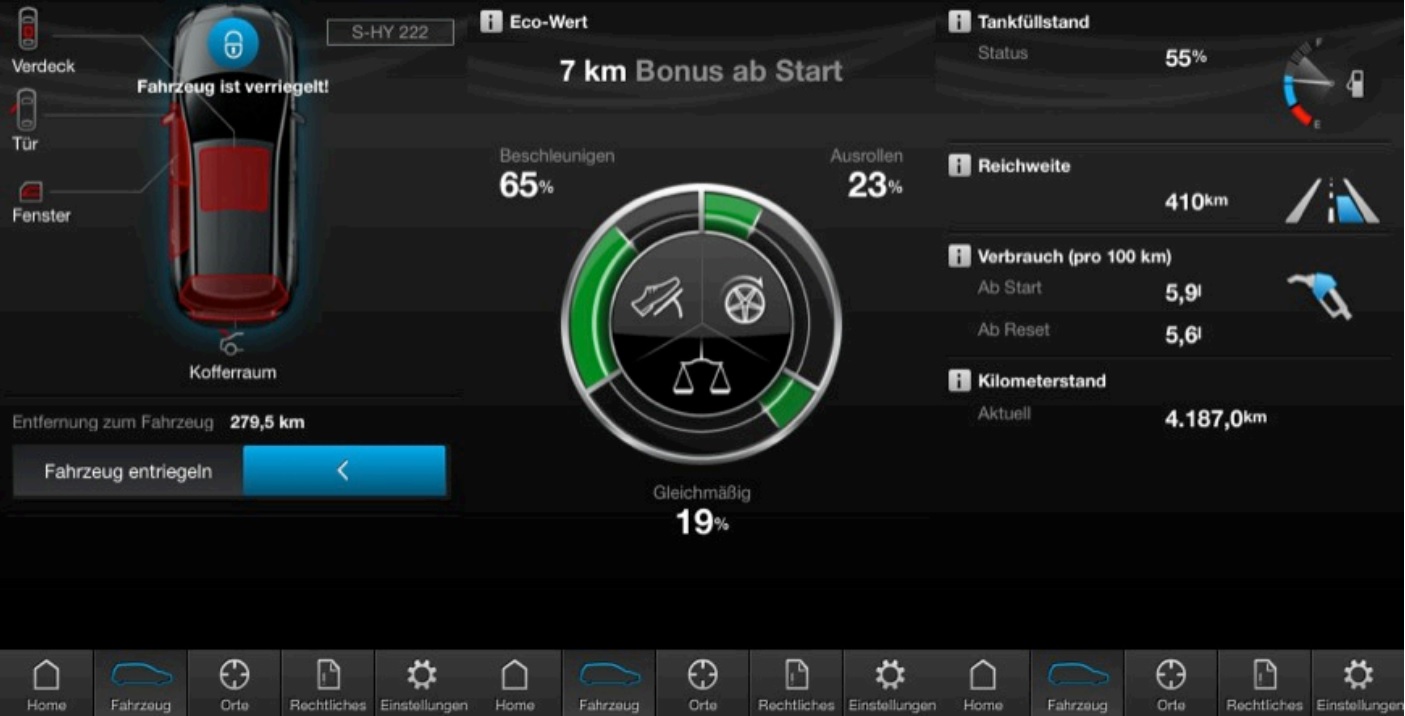
Daimler and its Mercedes-Benz brand offer a set of services called Mercedes me, which is broken down into five categories, including:
- Move me, which includes car2go (an Uber-like service), moovel (a trip-planning app) and Park2gether (an app for finding and purchasing parking), as well as car-rental, black-car hiring, taxi-hailing, carpooling, and public transportation–booking apps.
- Connect me, which includes remote smartphone apps for vehicle location, tracking and geofencing (which tells the driver the parking location if the vehicle leaves a defined area); gas/battery status; life traffic information; and the typical music, Internet radio, and hotel finder and weather services.
- Assist me, which covers maintenance and repair services.
Asian Manufacturers
Hyundai
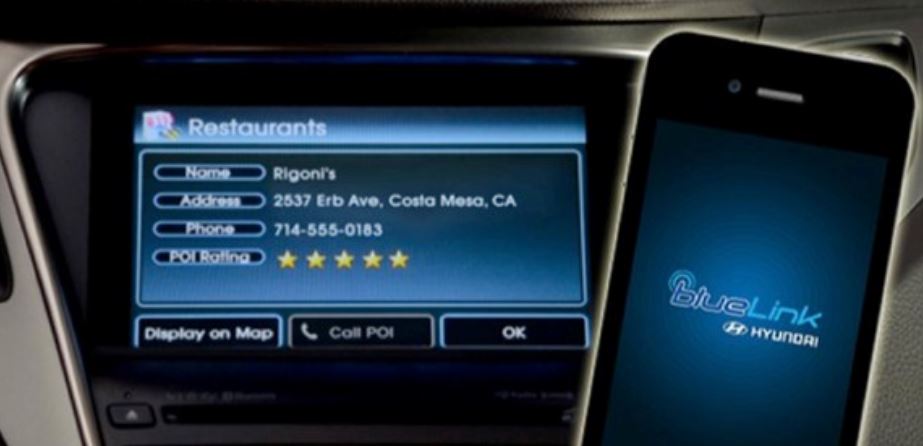
Hyundai’s
Blue Link system offers automatic collision notification (which also calls for help after an accident), emergency assistance, regular service scheduling and monthly vehicle health reports. It also features remote access functions via a smartphone, destination search (powered by Google) and control via a smartwatch app on Google Play.
Nissan
Nissan’s Bluetooth-based system for connecting to smartphones for the purposes of entertainment and 24-hour assistance is called
CARWINGS. At the 2015 New York Auto Show, the company announced a new Maxima model that includes NissanConnect Services, which link the car to the network by satellite (via SiriusXM satellite radio, paired cellphone or a built-in cellphone connection).
Regarding driverless cars, Nissan CEO Carlos Ghosn said in a recent interview that Nissan will offer autonomous driving technology in cars by 2020. Yet he sees it as adding to driving pleasure, and said that a totally driverless car is not central to Nissan’s plans.
Toyota
Toyota cars connect only to a driver’s smartphone at present. Its vehicles use HD radio to obtain traffic, weather and other information, and its
Entune app suite connects to smartphones via Bluetooth to provide music and information. Although the company announced the creation of a new department to unify its connected-car technologies in March 2015, it was exploring an open-source version of Ford’s AppLink system as of June 2015.

Other Technology Companies
Apple
Apple’s CarPlay is an iOS technology (for the iPhone 5 and 6) for getting directions, making phone calls, sending and receiving messages, and listening to music via voice control (using Apple’s Siri technology) or via compatible touch screens, knobs and controls inside the vehicle. CarPlay works with several iOS apps.
It’s also supported by two car-audio electronics manufacturers, Alpine and Pioneer, and by many major automobile manufacturers:

Apple is also rumored to be working an automobile project, codenamed “Titan,” which is could be an electric car based on BMW’s i3 model.
AT&T
AT&T also offers a hardware/software suite in connection with Audiovox called Car Connection 2.0, which plugs into a smartcar’s on-board diagnostics port and runs on its 3G UMTS wireless network or 4G LTE wireless network. The product works with selected 2015/2016 Audi models using Audi Connect; with selected 2015 Buicks, Cadillacs, Chevrolets and GMCs using OnStar from General Motors; and with selected Volvo models using Sensus Connect.
Car Connection 2.0 is also available via a software upgrade for Audiovox’s Car Connection Elite product. Alternatively, it can be purchased for $99, plus $10 for a monthly data plan, from AT&T. The device offers 24/7 roadside assistance, enhanced safety features, access to vehicle fuel and trip reports, and other features such as location assistance and remote unlocking via a smartphone app. AT&T is also providing the hardware for Tesla’s Model S wireless connectivity.
Delphi Automotive PLC
Delphi Automotive also offers a device that connects to the on-board diagnostics port of newer car models, similar to AT&T’s product. The Delphi Connect with 4G LTE Hotspot connects to Verizon Wireless’s network and to up to five Wi-Fi-enabled devices. It offers remote access such as door and trunk opening, Bluetooth smartphone connectivity, automotive diagnostics and monitoring, and vehicle location, all of which can be monitored via a smartphone app.
Google

Google, it seems, is not content to dominate just Internet search and smartphone software; the company is also flexing its muscles in connected-car software, and it appears to be the leader in the development of self-driving cars. The company has adapted its Android smartphone operating system software for automotive applications, branding it Android Auto.
Android Auto adds automobiles to the Android universe, which includes smartphones, tablets and smartwatches. The software is designed to work in conjunction with smartphones running Android OS version 5.0 (code-named Lollipop) or higher. Its functions include mapping, music, communication (phone calls and messages), speech technology and the ability to run applications.
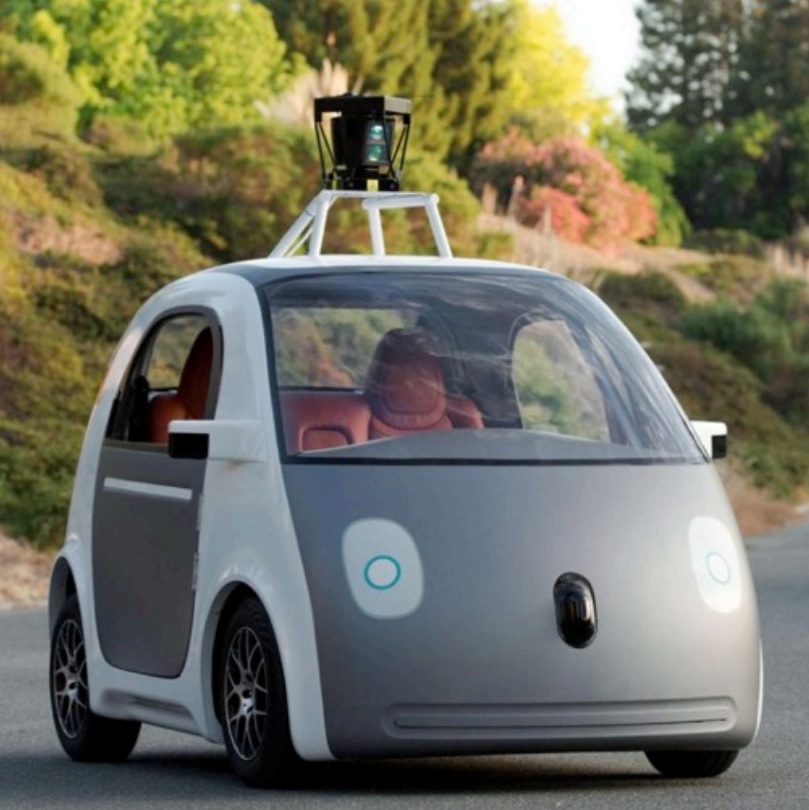 Send To Car was deactivated, but has been brought back.
Send To Car was deactivated, but has been brought back. The Send To Car app, which enables addresses, businesses and directions from Google Maps to be sent to one’s car, went offline in May 2013 due to incompatibility issues stemming from a software upgrade to Google Maps. However, after a user campaign, the Send To Car functionality in Google Maps was brought back in May 2014, and it currently works in cars and on GPS devices from Audi, BMW, Infiniti, Kia, Mercedes, MINI, Nissan and Rolls-Royce.
Self-driving cars: In May, Google announced that it was testing a fleet of 25 self-driving cars in the neighborhood around its headquarters in Mountain View, California. These cars are limited to speeds of 25 mph and must still carry a human driver, who can take the wheel in an emergency. To comply with California law, they contain a removable steering wheel and a gas pedal (for the human driver), although the cars themselves do not normally require them. Google’s first fleet of self-driving cars was based on modified Lexus vehicles, and suffered just 12 minor accidents in more than 1.8 million miles on the road, although none of those accidents were the cars’ fault. This is likely a lower accident ratio than for human drivers, as 94% of regular car accidents involve human error. Google publishes monthly reports on its blog, in which it provides statistics and discusses recent problems it has encountered.
Chinese Technology Companies Also Entering the Fray
The big three Chinese Internet companies—Alibaba, Baidu and Tencent—are also hard at work developing their own technologies for connected and driverless cars.
Alibaba acquired digital map content and navigation provider AutoNavi in April 2014 for $1.5 billion, which could indicate its interest in joining the connected-car industry.
This January,
Baidu launched
CarLife, a cross-platform solution for connected cars that was developed in partnership with global carmakers such as Audi, Hyundai and General Motors. Daimler has also announced a partnership with Baidu, for software based on Baidu Maps, the company’s digital-mapping service. The Daimler software facilitates route planning, location inquiries, distance estimation and navigation when connected to a smartphone via a cable or Wi-Fi. The company’s CEO mentioned in March that Baidu was working on autonomous vehicles and could introduce one this year.
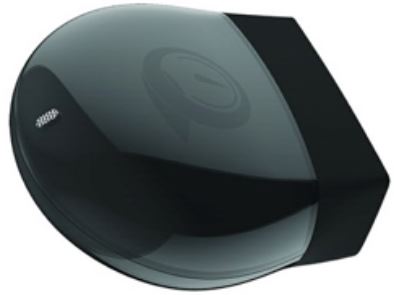 Tencent
Tencent, the developer of the WeChat messaging app, announced a partnership with Taiwan’s Foxconn and a Chinese luxury auto dealer to explore opportunities in developing smart electric vehicles. In June 2014, Tencent launched a smartcar device called Lubao Box, which connects vehicles to the cloud and enables drivers to check parameters such as fuel consumption.
Other Companies
There are several other companies of varying size developing products for connected cars, both commercially and in partnership with government entities.
Airbiquity offers a global connected-car platform called Choreo, which connects millions of vehicles and processes hundreds of millions of transactions each month at secure, private cloud data centers in Asia, North America and Europe. The company is located in Seattle, Washington, and has raised $35.4 million in two funding rounds from four investors.
INRIX leverages big data analytics to reduce the toll of traffic congestion and helps leading automakers, fleets, governments and news organizations make it easier for drivers to navigate their worlds.
Leidos was created in 2013, when the defense-contracting company formerly known as SAIC (Science Applications International Corporation) took a new name and spun off its government services and IT company under the old name. Leidos is currently researching a connected vehicle program with the US Department of Transportation and other federal, state and local government agencies, with a focus on deployment.
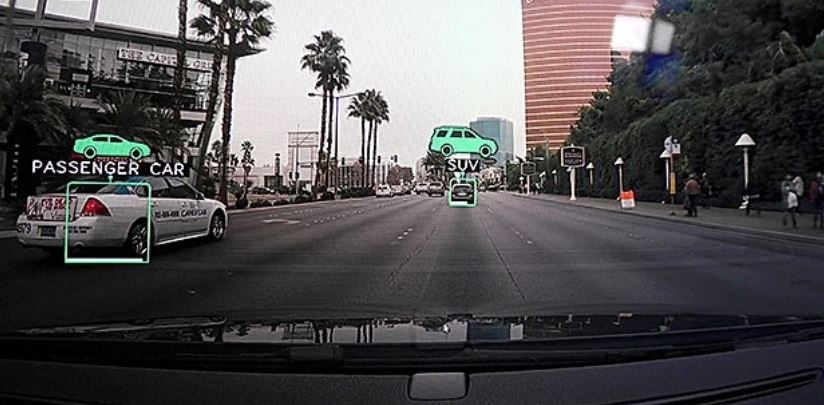
Publicly traded
Nuance Communications is a leading provider of voice and language solutions for businesses and consumers worldwide. Its Dragon Drive connected-car platform offers voice biometrics capabilities and a virtual assistant service that provides personalized content to a driver.
Video-processor chipmaker
NVIDIA demonstrated its technology for image processing in self-driving cars at the 2015 CES show. Company leaders discussed the challenges of identifying unexpected and unforeseen objects as well as pedestrians and cyclists.
QNX is a subsidiary of BlackBerry that offers operating systems, app and media software, software tools, acoustic-system design software, and platforms for use in industrial, medical, safety and security, and automotive infotainment systems.
At the 2015 CES,
Qualcomm demonstrated a connected Cadillac outfitted with its hardware, featuring its Snapdragon processor and software.
Conclusion
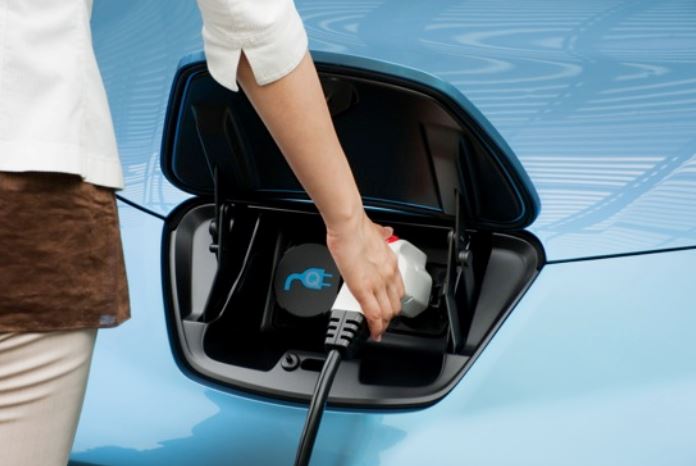
Connected cars combine two essential components of our modern lifestyles—automobiles and smartphones. This combination seems inevitable, as both cars and smartphones have become our mobile offices, concert halls and vanity mirrors. All hype aside, connected cars can serve important functions with regard to improving the driving experience and safety and reducing maintenance and repair costs. They can provide great convenience, too, saving drivers time by offering services such as the ability to park the car or quickly make restaurant reservations. Connectivity is becoming an essential, standard feature of today’s cars, as common as automatic transmission, power windows and airbags.




 In the graph below, we see that KPMG forecasts connected-car penetration to steadily increase from 2015 on, reaching full saturation in 2026. The firm sees level 3 production penetration rates increasing and then plateauing in 2024, and level 4 production penetration also increasing (please see definitions above), albeit at a lower level.
In the graph below, we see that KPMG forecasts connected-car penetration to steadily increase from 2015 on, reaching full saturation in 2026. The firm sees level 3 production penetration rates increasing and then plateauing in 2024, and level 4 production penetration also increasing (please see definitions above), albeit at a lower level.





 Source: Zubie.com[/caption]
Given the increasing number of new car models with better connectivity, there’s a large market for adding aftermarket connectivity to vehicles already on the road. The solution is probably in the hands of startup companies such as Zubie and Mojio, as well as Delphi Automotive and even AT&T, all of which are targeting the connected-car aftermarket.
Zubie and Mojio have developed connected devices that plug into the OBD-II (on-board diagnostic system) ports of cars. Through their respective mobile apps, these devices enable users to access driving and operations data, such as vehicle performance, location and driving habits.
Research firm Parks Associates estimates that there is a large addressable market for aftermarket solutions, since there are currently 233 million cars without a connectivity solution in the US alone.
Source: Zubie.com[/caption]
Given the increasing number of new car models with better connectivity, there’s a large market for adding aftermarket connectivity to vehicles already on the road. The solution is probably in the hands of startup companies such as Zubie and Mojio, as well as Delphi Automotive and even AT&T, all of which are targeting the connected-car aftermarket.
Zubie and Mojio have developed connected devices that plug into the OBD-II (on-board diagnostic system) ports of cars. Through their respective mobile apps, these devices enable users to access driving and operations data, such as vehicle performance, location and driving habits.
Research firm Parks Associates estimates that there is a large addressable market for aftermarket solutions, since there are currently 233 million cars without a connectivity solution in the US alone.




 Tesla has already booked 20,000 orders for the Model X sports-utility vehicle, which will come with falcon-wing doors and all-wheel drive powered by two independent motors. Delivery is estimated in September 2015, and the vehicle is expected to have a price tag of $70,000 to $105,000, a range of 215–270 miles, and an acceleration of 0 to 60 in 3.5 seconds.
The Model 3, currently under development, is being called an “all-electric vehicle for the masses,” priced at $35,000 and expected to be demonstrated in 2016 and going into production in 2017.
Tesla also boasts about its Supercharger—termed the world’s fastest charging station—which can charge a Model S in “minutes instead of hours.” The company currently operates 453 Supercharger stations with 2,519 Superchargers. These are located near restaurants, shopping centers and Wi-Fi hotspots. Owners can locate charging stations via Google Maps on the car’s 17" touch screen.
Tesla has already booked 20,000 orders for the Model X sports-utility vehicle, which will come with falcon-wing doors and all-wheel drive powered by two independent motors. Delivery is estimated in September 2015, and the vehicle is expected to have a price tag of $70,000 to $105,000, a range of 215–270 miles, and an acceleration of 0 to 60 in 3.5 seconds.
The Model 3, currently under development, is being called an “all-electric vehicle for the masses,” priced at $35,000 and expected to be demonstrated in 2016 and going into production in 2017.
Tesla also boasts about its Supercharger—termed the world’s fastest charging station—which can charge a Model S in “minutes instead of hours.” The company currently operates 453 Supercharger stations with 2,519 Superchargers. These are located near restaurants, shopping centers and Wi-Fi hotspots. Owners can locate charging stations via Google Maps on the car’s 17" touch screen.
 Ford calls its connectivity technology SYNC, which was announced at the 2007 Detroit International Auto Show and released that same year. SYNC uses a combination of voice commands, radio and steering-wheel buttons, and touch screens to allow drivers to control in-vehicle, entertainment, and smartphone or media player communications via Bluetooth.
Today, SYNC is offered in most Ford and Lincoln models and comes in three varieties:
Ford calls its connectivity technology SYNC, which was announced at the 2007 Detroit International Auto Show and released that same year. SYNC uses a combination of voice commands, radio and steering-wheel buttons, and touch screens to allow drivers to control in-vehicle, entertainment, and smartphone or media player communications via Bluetooth.
Today, SYNC is offered in most Ford and Lincoln models and comes in three varieties:
 Since 1996, GM cars have offered the OnStar system, which connects a driver to a 24/7 lifeline. The current version provides real-time, on-demand diagnostics via a RemoteLink mobile app. Starting in 2015, most new Chevrolet, Buick, GMC and Cadillac vehicles have offered OnStar with 4G LTE connectivity, which includes the following features:
Since 1996, GM cars have offered the OnStar system, which connects a driver to a 24/7 lifeline. The current version provides real-time, on-demand diagnostics via a RemoteLink mobile app. Starting in 2015, most new Chevrolet, Buick, GMC and Cadillac vehicles have offered OnStar with 4G LTE connectivity, which includes the following features:
 Audi started offering a 4G LTE wireless option in its A3 models in spring 2014. At the 2015 CES show, the carmaker demonstrated its new Q7 model and started calling its cars “mobile device[s],” demonstrating innovations such as voice-controlled navigation systems. If a driver says, for example, “Take me to the nearest Italian restaurant,” the navigation system will immediately display the best route.
Audi Connect is the company’s software that links a smartphone to Apple CarPlay and Android Auto, and the Q7 and TT models have an optional virtual cockpit that displays 3-D graphics and animations. The system also provides a Wi-Fi hotspot for up to eight devices and 4G wireless connectivity. The Q7 includes technology such as a Predictive Efficiency Assistant and adaptive cruise control, including a congestion assistant, which is a step toward piloted-driving technology. To demonstrate this technology, the company drove a concept car that used piloted driving from Silicon Valley to Las Vegas.
Audi’s most-recent A4 model, targeted to compete with BMW’s 3-series, is loaded with technology, including an 8.3” screen, the abovementioned virtual cockpit, Apple CarPlay and Android Auto, 4G LTE mobile hotspot connectivity, LED headlights, wireless cellphone charging, a heads-up display, and intelligent adaptive cruise control.
Audi’s most recent model, the A4, is targeted to compete with BMW’s 3 Series. The A4 is loaded with technology, including an 8.3" screen, the above-mentioned virtual cockpit, Apple CarPlay and Android Auto, 4G LTE mobile hotspot connectivity, LED headlights, wireless cellphone charging, a heads-up display, and intelligent adaptive cruise control.
Volkswagen demonstrated the e-Golf, or Connected Golf, at the 2015 CES show. The car includes VW’s latest-generation MIB II infotainment system, the latest version of its App-Connect software (which includes MirrorLink car connectivity software, and Android Auto and Apple CarPlay), tablet and smartwatch integration, intelligent charging, and guided parallel parking and exiting. The Golf R Touch is a highly electronic car that uses three flat-panel touch displays: a 12.8" high-resolution infotainment touch screen; an 8" Control Center for vehicle, climate control and media functions; and a 12.3" Active Information Display. The unique part is that these displays have incorporated gesture control, so that the driver is not distracted when selecting functions on the displays.
Porsche-branded vehicles use Porsche Car Connect software. The software includes Remote Services, which allow the driver to access vehicle information remotely and also control selected functions; Vehicle Tracking Services, which help the owner protect the car against theft and locate it if it’s stolen; and E-Mobility Services, which offer information and options tailored for vehicles with hybrid drive. The software also integrates with the new Apple Watch.
Audi started offering a 4G LTE wireless option in its A3 models in spring 2014. At the 2015 CES show, the carmaker demonstrated its new Q7 model and started calling its cars “mobile device[s],” demonstrating innovations such as voice-controlled navigation systems. If a driver says, for example, “Take me to the nearest Italian restaurant,” the navigation system will immediately display the best route.
Audi Connect is the company’s software that links a smartphone to Apple CarPlay and Android Auto, and the Q7 and TT models have an optional virtual cockpit that displays 3-D graphics and animations. The system also provides a Wi-Fi hotspot for up to eight devices and 4G wireless connectivity. The Q7 includes technology such as a Predictive Efficiency Assistant and adaptive cruise control, including a congestion assistant, which is a step toward piloted-driving technology. To demonstrate this technology, the company drove a concept car that used piloted driving from Silicon Valley to Las Vegas.
Audi’s most-recent A4 model, targeted to compete with BMW’s 3-series, is loaded with technology, including an 8.3” screen, the abovementioned virtual cockpit, Apple CarPlay and Android Auto, 4G LTE mobile hotspot connectivity, LED headlights, wireless cellphone charging, a heads-up display, and intelligent adaptive cruise control.
Audi’s most recent model, the A4, is targeted to compete with BMW’s 3 Series. The A4 is loaded with technology, including an 8.3" screen, the above-mentioned virtual cockpit, Apple CarPlay and Android Auto, 4G LTE mobile hotspot connectivity, LED headlights, wireless cellphone charging, a heads-up display, and intelligent adaptive cruise control.
Volkswagen demonstrated the e-Golf, or Connected Golf, at the 2015 CES show. The car includes VW’s latest-generation MIB II infotainment system, the latest version of its App-Connect software (which includes MirrorLink car connectivity software, and Android Auto and Apple CarPlay), tablet and smartwatch integration, intelligent charging, and guided parallel parking and exiting. The Golf R Touch is a highly electronic car that uses three flat-panel touch displays: a 12.8" high-resolution infotainment touch screen; an 8" Control Center for vehicle, climate control and media functions; and a 12.3" Active Information Display. The unique part is that these displays have incorporated gesture control, so that the driver is not distracted when selecting functions on the displays.
Porsche-branded vehicles use Porsche Car Connect software. The software includes Remote Services, which allow the driver to access vehicle information remotely and also control selected functions; Vehicle Tracking Services, which help the owner protect the car against theft and locate it if it’s stolen; and E-Mobility Services, which offer information and options tailored for vehicles with hybrid drive. The software also integrates with the new Apple Watch.
 Daimler and its Mercedes-Benz brand offer a set of services called Mercedes me, which is broken down into five categories, including:
Daimler and its Mercedes-Benz brand offer a set of services called Mercedes me, which is broken down into five categories, including:
 Hyundai’s Blue Link system offers automatic collision notification (which also calls for help after an accident), emergency assistance, regular service scheduling and monthly vehicle health reports. It also features remote access functions via a smartphone, destination search (powered by Google) and control via a smartwatch app on Google Play.
Hyundai’s Blue Link system offers automatic collision notification (which also calls for help after an accident), emergency assistance, regular service scheduling and monthly vehicle health reports. It also features remote access functions via a smartphone, destination search (powered by Google) and control via a smartwatch app on Google Play.

 Apple is also rumored to be working an automobile project, codenamed “Titan,” which is could be an electric car based on BMW’s i3 model.
Apple is also rumored to be working an automobile project, codenamed “Titan,” which is could be an electric car based on BMW’s i3 model.
 Google, it seems, is not content to dominate just Internet search and smartphone software; the company is also flexing its muscles in connected-car software, and it appears to be the leader in the development of self-driving cars. The company has adapted its Android smartphone operating system software for automotive applications, branding it Android Auto.
Android Auto adds automobiles to the Android universe, which includes smartphones, tablets and smartwatches. The software is designed to work in conjunction with smartphones running Android OS version 5.0 (code-named Lollipop) or higher. Its functions include mapping, music, communication (phone calls and messages), speech technology and the ability to run applications.
Google, it seems, is not content to dominate just Internet search and smartphone software; the company is also flexing its muscles in connected-car software, and it appears to be the leader in the development of self-driving cars. The company has adapted its Android smartphone operating system software for automotive applications, branding it Android Auto.
Android Auto adds automobiles to the Android universe, which includes smartphones, tablets and smartwatches. The software is designed to work in conjunction with smartphones running Android OS version 5.0 (code-named Lollipop) or higher. Its functions include mapping, music, communication (phone calls and messages), speech technology and the ability to run applications.
 Send To Car was deactivated, but has been brought back. The Send To Car app, which enables addresses, businesses and directions from Google Maps to be sent to one’s car, went offline in May 2013 due to incompatibility issues stemming from a software upgrade to Google Maps. However, after a user campaign, the Send To Car functionality in Google Maps was brought back in May 2014, and it currently works in cars and on GPS devices from Audi, BMW, Infiniti, Kia, Mercedes, MINI, Nissan and Rolls-Royce.
Self-driving cars: In May, Google announced that it was testing a fleet of 25 self-driving cars in the neighborhood around its headquarters in Mountain View, California. These cars are limited to speeds of 25 mph and must still carry a human driver, who can take the wheel in an emergency. To comply with California law, they contain a removable steering wheel and a gas pedal (for the human driver), although the cars themselves do not normally require them. Google’s first fleet of self-driving cars was based on modified Lexus vehicles, and suffered just 12 minor accidents in more than 1.8 million miles on the road, although none of those accidents were the cars’ fault. This is likely a lower accident ratio than for human drivers, as 94% of regular car accidents involve human error. Google publishes monthly reports on its blog, in which it provides statistics and discusses recent problems it has encountered.
Send To Car was deactivated, but has been brought back. The Send To Car app, which enables addresses, businesses and directions from Google Maps to be sent to one’s car, went offline in May 2013 due to incompatibility issues stemming from a software upgrade to Google Maps. However, after a user campaign, the Send To Car functionality in Google Maps was brought back in May 2014, and it currently works in cars and on GPS devices from Audi, BMW, Infiniti, Kia, Mercedes, MINI, Nissan and Rolls-Royce.
Self-driving cars: In May, Google announced that it was testing a fleet of 25 self-driving cars in the neighborhood around its headquarters in Mountain View, California. These cars are limited to speeds of 25 mph and must still carry a human driver, who can take the wheel in an emergency. To comply with California law, they contain a removable steering wheel and a gas pedal (for the human driver), although the cars themselves do not normally require them. Google’s first fleet of self-driving cars was based on modified Lexus vehicles, and suffered just 12 minor accidents in more than 1.8 million miles on the road, although none of those accidents were the cars’ fault. This is likely a lower accident ratio than for human drivers, as 94% of regular car accidents involve human error. Google publishes monthly reports on its blog, in which it provides statistics and discusses recent problems it has encountered.
 Tencent, the developer of the WeChat messaging app, announced a partnership with Taiwan’s Foxconn and a Chinese luxury auto dealer to explore opportunities in developing smart electric vehicles. In June 2014, Tencent launched a smartcar device called Lubao Box, which connects vehicles to the cloud and enables drivers to check parameters such as fuel consumption.
Tencent, the developer of the WeChat messaging app, announced a partnership with Taiwan’s Foxconn and a Chinese luxury auto dealer to explore opportunities in developing smart electric vehicles. In June 2014, Tencent launched a smartcar device called Lubao Box, which connects vehicles to the cloud and enables drivers to check parameters such as fuel consumption.
 Publicly traded Nuance Communications is a leading provider of voice and language solutions for businesses and consumers worldwide. Its Dragon Drive connected-car platform offers voice biometrics capabilities and a virtual assistant service that provides personalized content to a driver.
Video-processor chipmaker NVIDIA demonstrated its technology for image processing in self-driving cars at the 2015 CES show. Company leaders discussed the challenges of identifying unexpected and unforeseen objects as well as pedestrians and cyclists.
QNX is a subsidiary of BlackBerry that offers operating systems, app and media software, software tools, acoustic-system design software, and platforms for use in industrial, medical, safety and security, and automotive infotainment systems.
At the 2015 CES, Qualcomm demonstrated a connected Cadillac outfitted with its hardware, featuring its Snapdragon processor and software.
Publicly traded Nuance Communications is a leading provider of voice and language solutions for businesses and consumers worldwide. Its Dragon Drive connected-car platform offers voice biometrics capabilities and a virtual assistant service that provides personalized content to a driver.
Video-processor chipmaker NVIDIA demonstrated its technology for image processing in self-driving cars at the 2015 CES show. Company leaders discussed the challenges of identifying unexpected and unforeseen objects as well as pedestrians and cyclists.
QNX is a subsidiary of BlackBerry that offers operating systems, app and media software, software tools, acoustic-system design software, and platforms for use in industrial, medical, safety and security, and automotive infotainment systems.
At the 2015 CES, Qualcomm demonstrated a connected Cadillac outfitted with its hardware, featuring its Snapdragon processor and software.
 Connected cars combine two essential components of our modern lifestyles—automobiles and smartphones. This combination seems inevitable, as both cars and smartphones have become our mobile offices, concert halls and vanity mirrors. All hype aside, connected cars can serve important functions with regard to improving the driving experience and safety and reducing maintenance and repair costs. They can provide great convenience, too, saving drivers time by offering services such as the ability to park the car or quickly make restaurant reservations. Connectivity is becoming an essential, standard feature of today’s cars, as common as automatic transmission, power windows and airbags.
Connected cars combine two essential components of our modern lifestyles—automobiles and smartphones. This combination seems inevitable, as both cars and smartphones have become our mobile offices, concert halls and vanity mirrors. All hype aside, connected cars can serve important functions with regard to improving the driving experience and safety and reducing maintenance and repair costs. They can provide great convenience, too, saving drivers time by offering services such as the ability to park the car or quickly make restaurant reservations. Connectivity is becoming an essential, standard feature of today’s cars, as common as automatic transmission, power windows and airbags.